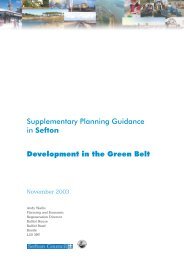The impact of sand extraction at Formby Point ... - Sefton Council
The impact of sand extraction at Formby Point ... - Sefton Council
The impact of sand extraction at Formby Point ... - Sefton Council
You also want an ePaper? Increase the reach of your titles
YUMPU automatically turns print PDFs into web optimized ePapers that Google loves.
19<br />
by blown <strong>sand</strong> is mentioned; these will require occasional repr<strong>of</strong>iling. <strong>The</strong> Plan also<br />
recommends the maintenance <strong>of</strong> “key pools” for N<strong>at</strong>terjacks <strong>at</strong> str<strong>at</strong>egic points along the<br />
coast.<br />
<strong>The</strong> present study shows th<strong>at</strong> the excav<strong>at</strong>ion <strong>of</strong> scrapes which breach the seasonal w<strong>at</strong>ertable<br />
can provide marked biodiversity improvements, particularly in respect <strong>of</strong> the humid<br />
dune-slack habit<strong>at</strong> and associ<strong>at</strong>ed notable plant species. Where terrestrial habit<strong>at</strong> is<br />
suitable, such scrapes have also been shown to provide vital spawning sites for the<br />
N<strong>at</strong>terjack Toad in landscape where this species would otherwise be unable to breed.<br />
4.2. Larger-scale<br />
<strong>The</strong> Ravenmeols and Lifebo<strong>at</strong> Road Management Plan advoc<strong>at</strong>es a feasibility study into<br />
repr<strong>of</strong>iling the <strong>sand</strong>-winning area in the southern part <strong>of</strong> Ravenmeols (i.e. <strong>at</strong> the western<br />
end <strong>of</strong> Range Lane) to improve the habit<strong>at</strong> for N<strong>at</strong>terjacks and Sand Lizards through the<br />
provision <strong>of</strong> mobile-dune and slacks. It makes no mention <strong>of</strong> the potential for similar<br />
works <strong>at</strong> Lifebo<strong>at</strong> Road.<br />
5. Potential for positive habit<strong>at</strong> management for BAP habit<strong>at</strong>s and species<br />
<strong>The</strong> following North Merseyside BAP habit<strong>at</strong>s and species are well represented in the<br />
<strong>sand</strong>-winning areas:<br />
HAPs: Sand Dunes.<br />
SAPs: N<strong>at</strong>terjack Toad, Sand Lizard, Dune Helleborine; Common Lizard, Northern<br />
Dune Tiger Beetle, Vernal Colletes Bee, Grayling, Dragonflies, Stoneworts, <strong>Sefton</strong> Coast<br />
Rare and Scarce Plants (hybrid willows).<br />
Burkmar (2006) has summarised North Merseyside BAP progress during the first five<br />
years <strong>of</strong> the Plan. As regards <strong>sand</strong>-dunes, the report emphasis the findings <strong>of</strong> G<strong>at</strong>eley &<br />
Michell (2004) and others th<strong>at</strong> the <strong>Sefton</strong> Coast dune system continues to be overstabilised<br />
with neutral grassland expanding in areas where fixed-dune or dry-slack<br />
veget<strong>at</strong>ion might be expected. An important factor may well be aerial deposition <strong>of</strong>















